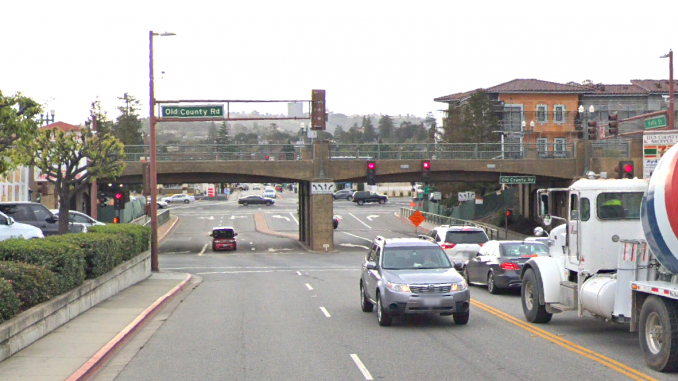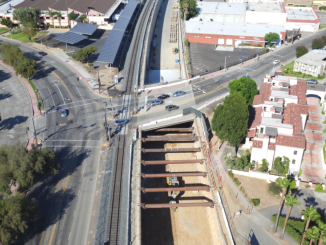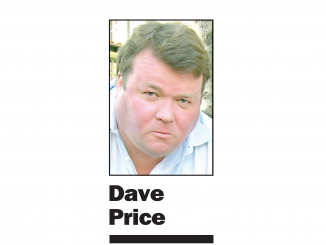
By EMILY MIBACH
Daily Post Staff Writer
The Measure W sales tax increase in San Mateo County is intended to fund transportation projects and programs to reduce traffic congestion. But very little of it will go toward solving an expensive problem that could create a great deal of traffic congestion — building bridges to separate streets from the Caltrain tracks, something planners call “grade separations.”
The need to build grade separations is urgent because when Caltrain goes electric, it will run trains more frequently, resulting in the crossing gates being down more often during commute hours. That will create massive traffic backups.
Of the $80 million this half-cent sales tax will generate annually, half will support the SamTrans bus and paratransit system. Only $2 million a year will go toward grade separations.
There are 32 at-grade crossings in San Mateo County, where the cars drive over the tracks. Some will get bridges while others will become dead-ends.
Menlo Park has looked into three grade separations at Ravenswood, Oak Grove and Glenwood avenues, which was estimated to cost about $380 million. Just separating the tracks at Ravenswood is estimated to cost about $190 million.
San Mateo is raising the tracks between Highway 92 and Hillsdale Boulevard and slightly lowering the road at 25th Avenue. This project is scheduled to be completed by 2020 and cost $180 million.
Redwood City is working on plans to separate Whipple Avenue.
The Measure W sales tax increase would provide $2 million a year for grade separations, or a total of $60 million (without adjustment for inflation) over the 30 years of the tax.
However, $60 million wouldn’t even pay for one grade separation.
But that isn’t the intent of the measure, said Sam-Trans Board member and Belmont Councilman Charles Stone.
“This is not a grade separation measure. This is a public transportation measure that has money for other things as well,” Stone said. “This is really a measure focused on getting people moving.”
Money would be for planning
The $2 million a year earmarked for grade separations will be used on planning the bridges so that cities can then go to the state and other agencies and get money for construction.
“The important thing that this (tax) does, is that even though there’s not enough for a lot of projects, it does continue to provide enough money for cities to continue their planning processes,” co-founder of Friends of Caltrain Adina Levin said.
Sometimes, cities need grants just to plan the grade separations, so having a pot of money for cities to use in order to plan projects will be useful, Stone said.
San Mateo County Supervisor Don Horsley suggested that cities could potentially use some of the $10 million set aside for local projects for grade separations.
Horsley said he originally petitioned for 3% of the tax to go to grade separations. The Board of Supervisors decided it should be 2.5% or $2 million a year.
However, Levin said some difficult decisions needed to be made when coming up with the measure’s expenditure plan, and decision makers found it more important to have a majority of the tax go to public transportation.
Half will go for SamTrans
Half of the tax, or $40 million annually, will fund SamTrans and its paratransit services, and $8 million, or 10%, of the tax will go toward mass transit projects, such as bringing a public ferry service to the Redwood City Port and reviving the Dumbarton rail line.
Another $18 million will go to highway improvements and $4 million will go to bicycle and pedestrian improvements.
The tax will have to be approved by a two-thirds majority in order to pass in November.
It’s likely that another transportation tax will be on the November 2020 ballot. Caltrain is expected to ask for an eighth of a cent sales tax in San Mateo, Santa Clara and San Francisco counties.
That sales tax would bring Caltrain about $100 million per year. The new money would replace the $30 million in annual contributions the three counties make each year.




San Mateo County and SamTrans used public funds to create the campaign promoting Measure W on the ballot this November. THIS SHOULD BE A FELONY!
TBWB Strategies was identified as the firm which masterminded the Get Us Moving(GUM) campaign paid for with >$1,000,000 of taxpayer dollars.
I have been trying to track campaign activity by the YES on W supporters. Searching the SMC Election website for YES on W comes up empty. Also, searching that site under “View Existing Campaign Finance Reports” “11/06/2018” “Measures” also comes up blank for Measure W.
After receiving a glossy mailing from TBW(parent of TBWB) I was able to retrieve the FPPC 460 and 497 campaign filings for the committee “Yes on W – San Mateo County Neighbors for Congestion Relief” using their FPPC ID# 1407448. Even though those filings clearly identified the committees FULL name, SMC Elections has left off the Yes on W part of the Committee name! You can obtain copies of those filings on my website: http://www.xshcd.com/W. The Yes on W campaign has raised more than $760,000. They hired Terris, Barnes and Walters(TBW) as their campaign consultant. That is Step 4 in TBWB’s approach to successful public finance measures that involves five critical steps. See: http://www.tbwb.com/approach
NOTE: A search of the Sam Trans and San Mateo County websites for TBWB failed to find any info. This is because they used an intermediary, the Louis Berger Group. See: “Work Directive PR” at http://www.xshcd.com/W/Get%20Us%20Moving%20PRA/
Step 4. CAMPAIGN FOR THE WIN
The next step in the process is to mount a strategic advocacy campaign to secure the votes needed to win on Election Day. As consultant to volunteer campaign committees, we build campaign plans with the following elements to ensure the best possible chance of success on Election Day:
UNIQUE. We pride ourselves in developing unique plans for every client as opposed to applying a “cookie cutter” model that may have worked in other places or at other times.
EFFECTIVE MESSAGING AND MATERIALS. Campaign logos, brochures, websites, social media and other materials must be eye-catching and have a local feel in order to persuade and motivate voters effectively.
AVOIDING CONTROVERSY AND OBSTACLES. We can’t take anything for granted in today’s economic and political environment. To win, it is important to run an organized campaign that avoids controversy and neutralizes opposition to the extent possible.
GOOD TEAMWORK. Above all, winning campaigns take good teamwork. We work closely with pollsters, professionals, committee members and other local partners.
Efficient grassroots organizing. The time and energy of your volunteers are precious resources. We’ll work with you to develop a plan that maximizes the impact of their efforts on the outcome of the election.
STRONG FUNDRAISING. Fundraising for local ballot measures can be a challenge. It takes resources to get your message out to the voters who will determine the outcome of your election. We can help you create a fundraising plan to help you achieve the resources needed to win.
The “grassroots” organizing was likely helped by the gathering of e-mail addresses while in Step 2 of the Approach, “Building Consensus”, which includes “Write, design, and produce informational mailings to educate, inform and engage voters.”
See also: https://www.almanacnews.com/square/2018/08/29/vote-no-on-measure-w-sales-tax